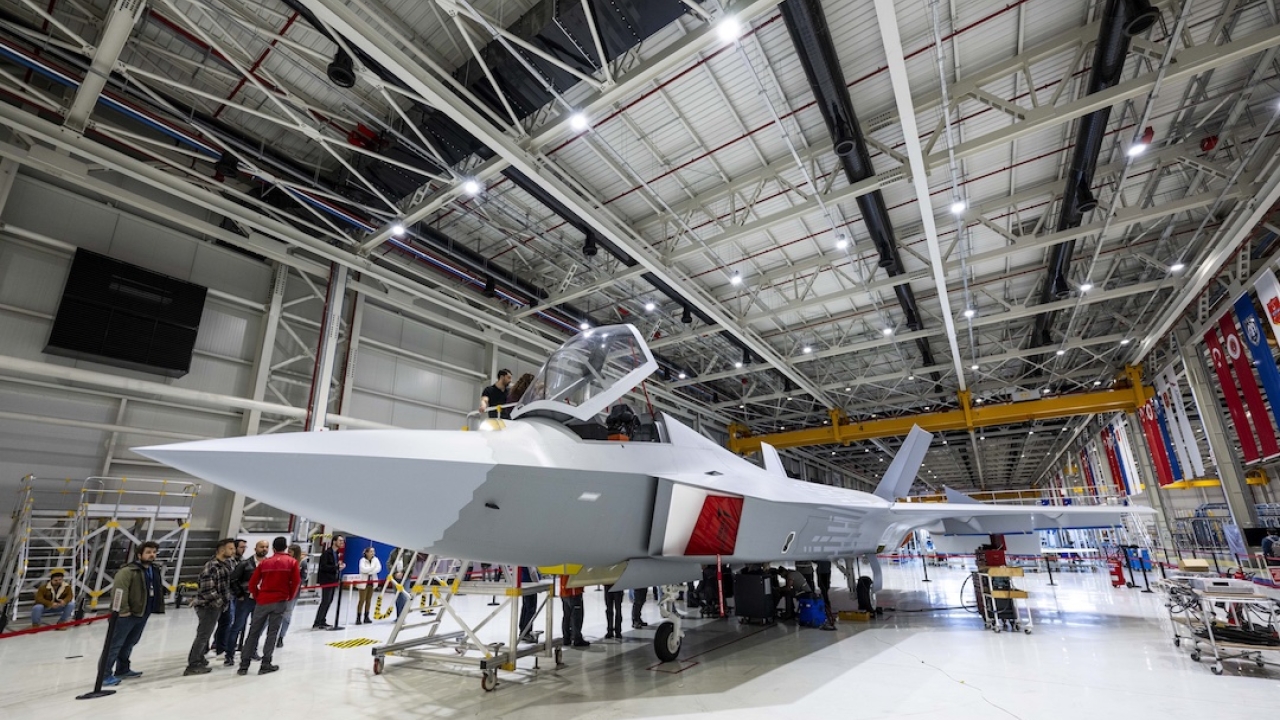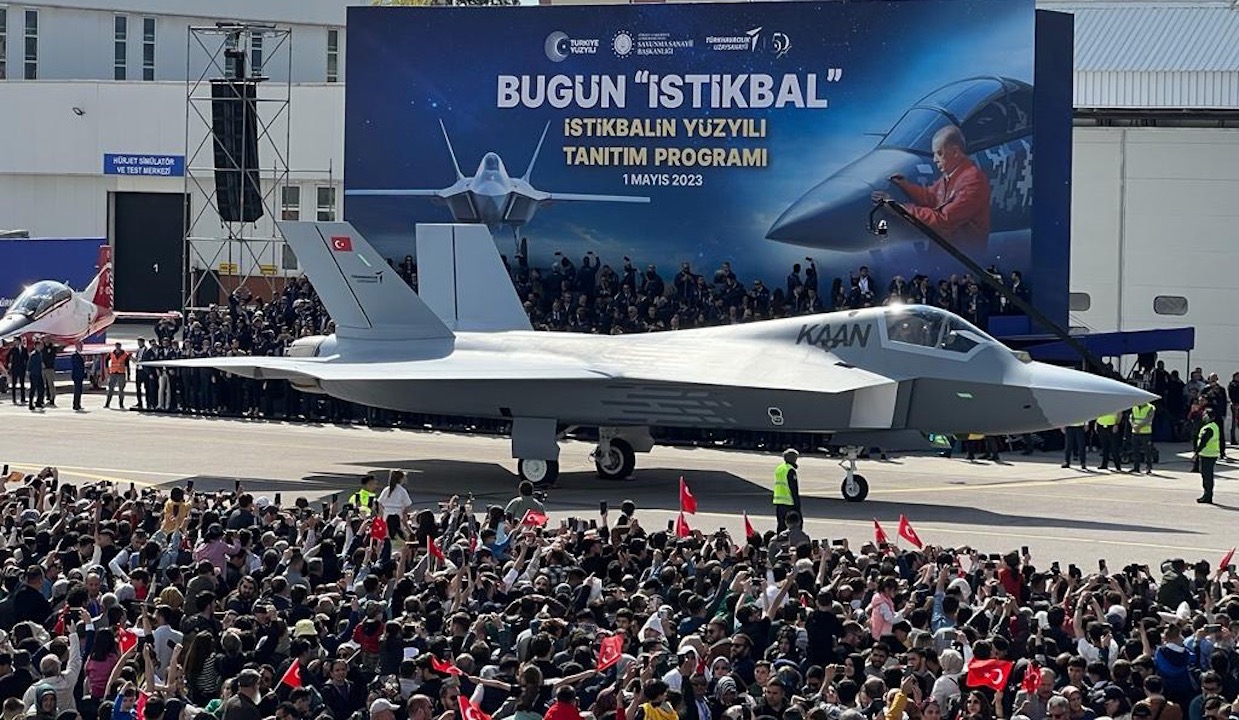Kaan's kingdom...
Previously known as the TF-X, Turkey’s new indigenous fifth-generation Kaan National Combat Aircraft (Milli Muharip Uçak, or MMU) has assumed a new importance in recent years.

On the blocks: 250 of these stealthy tactical fighter aircraft are due to be procured between 2029-2040. Picture: Turkish Aerospace
Despite the tragic Turkish earthquakes in early February, TAI did taxy its MMU prototype on March 16, prior to a relatively low-key ceremonial rollout, which took place as planned, on March 18.
This date is celebrated in Turkey as victory day, commemorating the battle of Çanakkale, (also known as Gallipoli). The date had a particular resonance this year, since 2023 is the 100th anniversary of the founding of modern Turkey by Kemal Attaturk. Planned first flights of the Hürjet advanced trainer and ATAK-2 attack helicopter were not achieved that day.
The fact that the MMU taxied as planned reflects the importance placed on the programme, and its priority status. The Turkish air force always planned to base its future force structure around a high/low mix of fighter aircraft types. About 100 Lockheed Martin F-35s were originally to have provided the ‘high end’ element – accounting for about 25 per cent of the force, and replacing the 30 or so McDonnell Douglas F-4E-2020 Phantoms and those Lockheed Martin F-16s tasked with the strike/attack role.
The new MMU was intended to be the cheaper, less-capable element in the high/low mix, replacing the remainder of the air force’s 238 F-16C/Ds.
With the termination of the F-35, triggered by Ankara’s procurement of the Russian S-400 air defence missile system, these plans changed, and the Turkish ministry of defence was forced to chart a new course forward.
The F-4E is now likely to serve a little longer, and the MMU will now form the ‘high end’ element in the future force, with the F-16 being upgraded and retained beyond the originally planned 2030 OSD (for the Block 30 and 40) to operate alongside the MMU.
What would have been an all-stealth force (F-35 and MMU) will now be an all-AESA force with the MMU and F-16 (Özgür, Block 70 and F-16V). Upgrading the F-16 should fulfil Turkish air defence requirements in the short-to-medium term, though it is unclear as to how well the MMU will meet the high-end platform requirement, and whether it will adequately replace the F-35A.
There is no real alternative for Turkey, however, and the MMU programme has now been designated as a “national survival project.”
Some 250 of these stealthy tactical fighter aircraft are due to be procured between 2029-2040, for service from the 2030s out to the 2070s, in a three-phase programme.
Phase one, stage one began in 2018 and included the system requirements review (SRR), which saw the air force’s operational requirements being translated into objective, measurable plans. Phase one also included a system functional review (SFR) which broke down the requirements at a system level and identified and set the key user requirements (KURs). It also included the preliminary design review which finalised the aircraft’s detailed preliminary design in terms of its shape, sensors and sub-systems.
Stage two of the first phase is now under way, the challenging timelines so far having been facilitated through the use of a ‘digital twin’, using the Dassault Systemes’ 3DExperience product lifecycle management (PLM) platform.
Stage two includes detailed design work and qualification of the design through the use of three block ‘0’ development aircraft (or seven ‘prototypes’ according to some company sources).
The first of these, known as GTU-0, is the aircraft that was rolled out on March 18 2023, and is a technology demonstrator, lacking operational systems, and unrepresentative of the planned production configuration. The aircraft undertook its first taxy trial on March 17, at speeds of up to 15 kts.

The aircraft made a public appearance on May 1, when it was named Kaan (‘ruler’ or ‘king of kings’) by Turkish president Recep Tayyip Erdoğan during a "century of the future" event at the Turkish Aerospace Industries (TAI) Ankara headquarters.
The three block ‘0’ development aircraft will be powered by two General Electric F110 engines, although later aircraft are expected to use indigenous engines.
The second prototype (known as P1) is due to fly in 2025, and will be more representative of the planned production aircraft, and will cover the entire envelope. The third aircraft is expected to fly in 2026.
Phase two will begin in late 2028 and will include the delivery of ten block one aircraft to the Turkish Air Force between 2030-2033. The delivery rate will rise to two aircraft per month by 2029.
Phase three will begin in 2034 with follow-on blocks being delivered that year and into the future. The block 20 MMU will be a true fifth generation fighter, with LO-appropriate materials, coatings, sensors and systems, and with super-cruise capabilities. The definitive production MMU aircraft will use an advanced carbon composite fuselage for the TF-X, using new lighter carbon composite thermoplastic materials developed by TAI's advanced carbon composites fuselage facility, which was previously tasked with producing F-35 fuselages.
The MMU is equipped with a highly-integrated and domestically-developed sensor suite, including a new active electronically scanned array (AESA) radar being developed by Aselsan using the latest gallium nitride (GaN) technology, an integrated electro-optical system (IEOS) includes a dedicated infrared search and track (IRST) sensor and an electro-optical targeting system (EOTS) and a new electronic warfare (EW) and self-protection system.
Indigenous content is a vital part of the MMU. Professor Dr Temel Kotil, the CEO of Turkish Aerospace Industries, has highlighted and emphasised the involvement of Turkish companies in the design and development of all aspects of the MMU, which he insists will ensure the operational sovereignty of the aircraft. He said: “We have Aselsan for avionics and computer hardware, we have Havelsan for software, and TAI also has its software team.” The aircraft will also use indigenous weapons where possible.
The MMU is optimised as an air superiority fighter, but will also have a robust secondary ground-attack capability. In the air-to-air role, the aircraft’s armament options will include the MBDA Meteor and MICA, and Raytheon’s AIM-120 advanced medium-range air-to-air missile (AMRAAM), as well as the indigenous Gökdoğan missile, while short-range weapons will include AIM-9X, advanced short-range air-to-air missile (ASRAAM), and the Turkish Bozdoğan missile. In the longer term, MMU is likely to incorporate directed energy and electromagnetic pulse weapons.
The MMU’s air-to-ground weapons options, will include a newly-developed reconnaissance pod. In low observability (LO) configuration, the MMU will have only a modest internal 1,000lb weapon load, primarily using small precision-guided munitions (PGMs) like Aselsan’s new Tolun, an INS/GPS-guided winged munition with a stand-off range of 60 miles. The aircraft can also carry the compressed carriage TÜBİTAK SAGE SOM-J cruise missile, which was originally designed for internal carriage by the F-35A, with folding control surfaces and a booster.
In a non-stealthy configuration, the aircraft has six external hardpoints, and will carry a much heavier bomb load, including other variants of the SOM (Satha Atılan Orta Menzilli Mühimmat) next-generation cruise missile, including the SOM-B1 with infrared terminal matching, and the SOM-B2 with a two-stage penetrator warhead.
Like other new fighters in development, including the US next-generation air dominance (NGAD), the Anglo-Italian-Japanese global combat air programme(GCAP) Tempest and the Franco-German-Spanish future combat air system (FCAS), the MMU manned fighter will form part of a system of systems, augmented by an array of adjuncts and effectors, with encrypted datalinks that will allow it to control accompanying loyal wingmen and swarming drones.
These are likely to include the new MİUS (Muharip Insansiz Ucak Sistemi) unmanned combat aircraft system, a requirement that could be fulfilled by Baykar’s Kızılelma, or by TAI’s own Anka 3.
Stay up to date
Subscribe to the free Times Aerospace newsletter and receive the latest content every week. We'll never share your email address.


